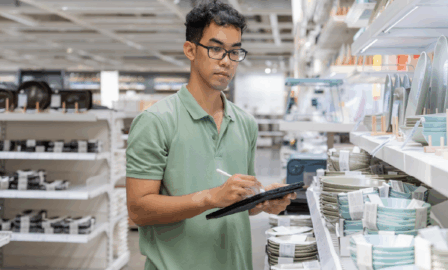The Critical Components of Reverse Logistics in Retail
In the margin target world of retail sales, ensuring a smooth flow of products from the manufacturer to the end consumer is paramount. However, the sale doesn’t end with a successful purchase. As the retail landscape continues to grow and evolve, businesses are increasingly recognizing the need to embrace the complexities of reverse logistics in retail to effectively manage the flow of products in the opposite direction.
What is Reverse Logistics?
Reverse logistics refers to the process of managing and handling the flow of goods, materials, or products from their point of consumption or use back to their point of origin or manufacturer. It encompasses the reverse movement of products in the supply chain after they have been delivered to the end user or customer. Reverse logistics includes product returns, repairs and refurbishment, remanufacturing, redistribution, recycling and disposal, the transportation and shipping process, liquidation and secondary markets, and data analysis.
The introduction and rise of retail eCommerce and online shopping venues such as Amazon and Alibaba have significantly influenced customer behavior and made online purchasing more convenient and easier but has also led to an increase in product returns. Additionally, with this highly competitive environment, retailers risk not meeting customer expectations if excellent customer service and hassle-free returns policies are not in place. Reverse logistics plays a crucial role in facilitating these returns efficiently, which is essential for customer satisfaction and retention. As a result, retailers are recognizing the strategic importance of reverse logistics in maintaining a competitive edge and building brand loyalty.
Components of Reverse Logistics in Retail
For this piece, we will focus on components of reverse logistics in retail to ensure a margin-driven approach.
- Cost Efficiency and Inventory Management
Inefficient reverse logistics may result in financial losses for retailers. Unplanned returns, excessive handling, and improper storage of returned products can lead to increased operating costs and inventory write-offs. On the other hand, well-optimized reverse logistics processes enable retailers to identify items that can be dispositioned appropriately either by restocking, refurbishing, repairing damaged goods, and recycling or disposing of items responsibly. By managing retail returns effectively, retailers can minimize costs, reduce excess inventory, and optimize supply chain operations.
- Managing Returns and Customer Satisfaction
An automated, seamless, and customer-centric returns process is a hallmark of successful retailers. Reverse logistics provides the framework to manage product returns efficiently, empowering retailers to promptly address customer concerns. By streamlining the returns process, businesses can improve customer satisfaction by making it easy to send back products as well as foster positive relationships with their clientele. Satisfied customers are more likely to become repeat buyers and advocates for the brand, contributing to this sustainable loyalty and growth.
- Sustainability Through Reverse Logistics
In a world increasingly focused on environmental consciousness, reverse logistics provides a golden opportunity for retailers to demonstrate their commitment to sustainability. Instead of discarding returned products, retailers can implement eco-friendly practices, such as refurbishing, remanufacturing, and recycling, and we’re seeing growth in reCommerce. By reducing waste and promoting a circular economy, businesses can contribute to a greener future while enhancing their brand image among environmentally conscious consumers.
- Challenges and Opportunities in Reverse Logistics
While reverse logistics offers significant advantages, it also comes with its share of challenges. Retailers must navigate complexities, such as reverse supply chain visibility, quality assessment of returned items, and managing partnerships with third-party logistics providers for returns processing. However, with every challenge comes an opportunity. By leveraging technology and data analytics, retailers can gain insights into return patterns, identify potential issues, and fine-tune their reverse logistics processes for continuous improvement.
- Data Capture
Data capture plays a crucial role in the efficient and effective implementation of reverse logistics processes. The ability to capture data in real time and share via multiple platforms benefits both retailers and customers. Retailers can identify return trends, analyze customer behavior, identify potential quality issues, make adjustments to design or distribution strategies, and determine relevant actions to improve the customer experience. For example, when retailers included a pre-printed label for a customer to use when returning goods, customers benefit by receiving immediate credits once the item is scanned by a carrier. This goes a long way in building trust with customers. The retailer also benefits from optimized return processing and advanced planning on next steps. A data-driven approach enables retailers to make informed decisions, optimize operations, and enhance customer satisfaction.
Leveraging Reverse Logistics in Retail
Reverse logistics has evolved with the introduction of eCommerce, moving technology from an operational necessity to a strategic imperative in the modern retail landscape. Retailers that can embrace, evolve, and lead reverse logistics practices can create a positive impact on customer satisfaction, cost efficiency, and environmental sustainability.
A well-managed returns process not only enhances customer loyalty but also presents opportunities to optimize inventory levels and reduce operational costs. As the retail industry continues to adapt to changing customer demands and environmental concerns, mastering reverse logistics will be a defining factor for retailers seeking long-term success and growth in the competitive marketplace. If you’re seeking guidance on designing your logistics strategy or optimizing your retail supply chain, our team can help.
Subscribe to Clarkston's Insights
Contributions from Ash Sarandah



